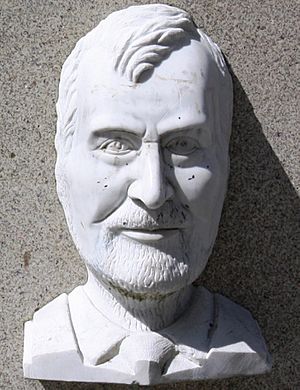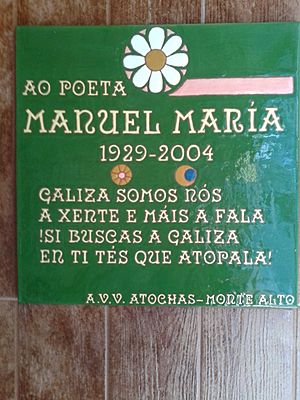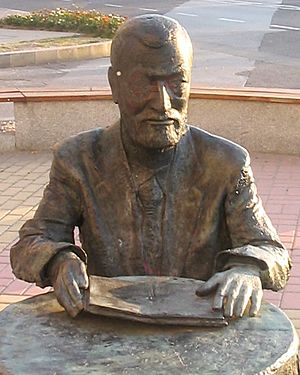Manuel María Fernández Teixeiro facts for kids
Quick facts for kids
Manuel María Fernández Teixeiro
|
|
|---|---|

The bust of Manuel Maria in the Plaza Mayor de Lugo
|
|
| Born | October 6, 1929 |
| Died | September 8, 2004 (aged 74) A Coruña, Galicia
|
| Nationality | Spanish, Galician |
| Occupation | Poet, Academic |
Manuel María Fernández Teixeiro, known simply as Manuel María, was an important Spanish poet and academic. He was born on October 6, 1929, in Outeiro de Rei, and passed away on September 8, 2004, in A Coruña. He wrote all his works in the Galician language.
Manuel María was known for being a strong and dedicated person. He cared deeply about his home region, Galicia. His poems explored many topics. These included love, art, and his strong beliefs about society. He also wrote about history, nature, and the passing of time. In 2016, the Galician Literature Day was dedicated to him. This shows how much he meant to Galician culture.
Contents
Manuel María's Life Story
Manuel María grew up in a farming family. His parents, Antonio Fernández Núñez and Pastora Teixeiro Casanova, were well-off farmers. His father was even the mayor of Outeiro de Rei. Manuel María went to primary school in his small village of Rábade.
In 1942, he moved to Lugo to continue his studies. There, at just 20 years old, he started his writing journey. He joined a group of young writers and met important people like Luís Pimentel and Ánxel Fole. This was how he first learned about "Galicianism." This was a movement to support and promote Galician culture and language. He also became good friends with another poet, Uxío Novoneyra, around this time.
In 1950, Manuel María published his first book of poems, Muiñeiro de brétemas (which means "Miller of mists"). After not getting into the University of Santiago, he wrote his second book, Morrendo a cada intre ("Dying every minute"). He later served in the military in Santiago de Compostela. He then returned to Lugo to study law.
In 1958, he became a court attorney in Monforte de Lemos. He lived there for most of his life. He even wrote a book of poems dedicated to the city, called Cancioneiro de Monforte de Lemos. The next year, he married Saleta Goi García.
While poetry was his favorite way to write, Manuel María also wrote essays, stories, and plays. He changed his writing style over time. He moved from a sad, philosophical view to writing about social and political issues. In the 1960s and 1970s, he secretly helped to restart Galician nationalist groups. He also worked with groups that wanted to bring back Galician culture. He gave talks and read his poems. He even helped run a publishing house and a bookshop.
In 1970, he became a member of the Royal Galician Academy. This is a very important group for the Galician language. However, he left the Academy in 1975.
Manuel María was a strong supporter of Galician political groups. In 1979, he was elected as a local council member in Monforte. He left this role in 1985 and moved to A Coruña. There, he focused completely on his writing and cultural work. He wrote a regular newspaper column called Walking on Earth for the newspaper Our Earth. One of the last big events he took part in was helping with the response to the Prestige oil spill disaster. He joined groups like Burla Negra and the Plataforma Nunca Máis ("Never More" Platform). These groups protested the oil spill and demanded action.
In 1997, he was honored by the Galician Writers Association. In 2003, he rejoined the Royal Galician Academy. He passed away in A Coruña on September 8, 2004. He was buried in his hometown of Outeiro de Rei.
Honours and Recognition
Manuel María's home in Outeiro de Rei, called Casa das Hortas ("the House of the Vegetable gardens"), was opened as a museum on September 7, 2013. This allows people to learn more about his life.
On July 4, 2015, it was announced that the Royal Galician Academy would dedicate Galician Literature Day in 2016 to Manuel María. This special day, held on May 17, celebrates important Galician writers.
Manuel María's Works
Manuel María wrote many books and poems throughout his life. Most of his works were in Galician. He explored many different styles and themes.
Poetry
He published his first poetry book, Muiñeiro de brétemas, in 1950. He wrote many more poetry collections over the years. Some of his notable works include Terra Chá (1954), Mar Maior (1963), and Canciós do lusco ao fusco (1970). His poems often talked about his love for Galicia, its people, and its landscapes. He also used poetry to share his thoughts on society and politics.
Prose
Manuel María also wrote stories and other prose works. These included Contos en cuarto crecente e outras prosas (1952) and O xornaleiro e sete testemuñas máis (1971). He often used his prose to tell tales about everyday life and people.
Drama
He wrote several plays, or dramas. These included Auto do taberneiro (1957) and Barriga verde (1973). His plays sometimes used traditional Galician forms and often had a message about society.
Juvenile Works
Manuel María also wrote books specifically for younger readers. These included Os soños na gaiola (1968) and As rúas do vento ceibe (1979). These stories were often imaginative and fun for children.
Essays
He wrote essays where he shared his thoughts and knowledge. These included Notas en col da poesía de Fermín Bouza-Brei (1958) and Andando a Terra (1990). His essays often focused on Galician culture, literature, and history.

See also
 In Spanish: Manuel María para niños
In Spanish: Manuel María para niños



